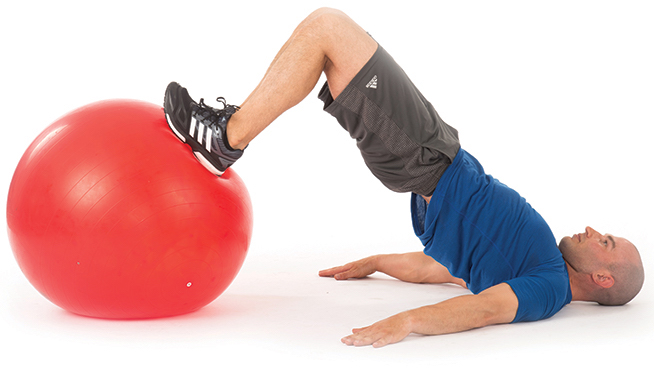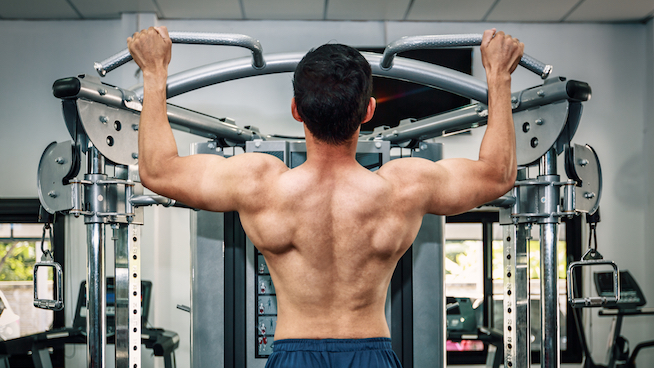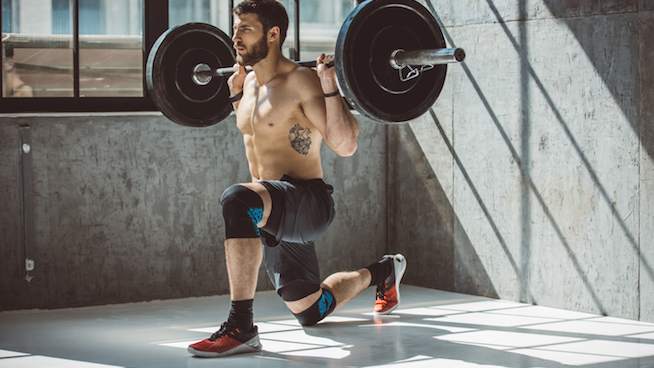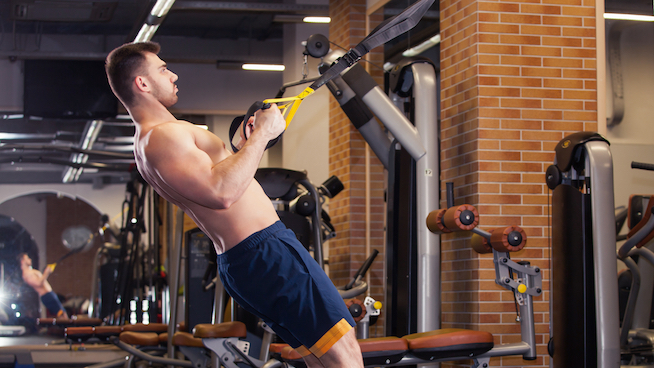What Do You Need to Know for Full Stack
What is an Accessory Exercise? Everything Yous Need to Know Nigh These Training Staples
If you're new to strength training, it tin can exist easy to feel overwhelmed by the barrage of vocabulary words existence thrown your way.
Not only are you learning the names of exercises, just you're as well learning the names of dissimilar training principles, preparation styles, pieces of equipment, etc.
One popular term y'all'll often hear in and effectually the weight room? Accessory exercises. While you lot may have some idea what this term entails, learning the definition and function of accessory exercises can brand you a more knowledgeable gym-goer and aid you get the virtually out of every workout.
What are Accessory Exercises?

To understand the importance of accessory exercises in your workout, you must outset empathize the importance of primary exercises.
Primary exercises go past a lot of names—the "big lifts," the "cadre lifts," the "main lifts"—all of these terms are often used interchangeably with primary exercises. To break it down, your chief exercises are the lift (or lifts) you perform immediately afterward your warm-up. These oft include exercises like the Squat, Deadlift, Bench Press and Make clean, along with slight variations on these movements (such equally the Ability Make clean or Trap Bar Deadlift). The reason these exercises are performed at the start of your workout is because they are the almost important exercises in your routine.
You want to set on these lifts with a total tank of energy, because the benefits they offer when performed correctly and with maximum intensity are simply unmatched. If you want to build muscle mass, become stronger, run faster and get more resistant to injury, nothing will give y'all more than bang for your buck quite than the primary lifts.
However, if y'all ended all your workouts upon the conclusion of your master exercises, your training sessions would only last about 25 minutes. The exercises and movements you employ to fill out the rest of your workout are known every bit accessory exercises.
What's the Purpose of Accompaniment Exercises?

Accessory exercises serve many purposes.
For 1, they allow y'all to continue to train after you finish your primary exercise or exercises—admitting at a lower intensity. But because you're slightly drawn doesn't mean you shouldn't go on training, and accessory exercises offer you the chance to do that without the same risk of injury/overuse you lot'd be exposed to if you just performed primary exercises over and over.
Accessory exercises also let you to focus on different muscle groups—or hit certain musculus groups in different ways—than the primary exercises. This ultimately reduces your weakness and imbalances and makes you a stronger and more resilient gym-goer. When used properly, non simply will accessory exercises make y'all stronger and more adept in a variety of movement patterns, merely they'll also assistance you get amend and stronger at your primary exercises.
Accessory exercises are typically performed for more reps than master exercises. Many effective workouts often follow this rough order:
- Warm-upwards
- 1 or ii primary exercises
- Ii to three supersets of accessory exercises
What are Some of the Best Accessory Exercises?

While there are only a small handful of master exercises, there are literally hundreds of accessory exercises at your disposal. Choosing the right ones for your routine comes downward to your goals and ability level.
Truth exist told, a lot of the accessory exercises out there—even some that are quite popular—aren't all that beneficial. They either don't offer much bang for your buck, or there are safer options available which are only as constructive. Examples include Car Leg Extensions, Tricep Kick-Backs, Dumbbell Side Bends, Upright Rows and Crunches.
Are these exercises better than zippo? Perhaps, but there'southward so many better options bachelor. Some smarter accompaniment exercises include:
- Reverse Lunges
- Stability Ball Hamstring Curls
- Pull-Ups
- Skullcrushers
- Bent-Over Rows
- Expressionless Bugs
- Ab Rollouts
- Inverted/TRX Rows
- Cable Lifts & Chops
- Glute-Ham Raises
Among many, many others.
Yous'll notice that many of these exercises practice not make use of traditional gym machines. That'due south no accident—generally speaking, free weights or machines which permit for significant ranges of motility (such as cable machines) offer greater overall benefits than machines that restrict yous to only ane range of motion (such every bit a leg extension machine). This isn't to say traditional gym machines are worthless, but they only don't offer quite as many benefits—especially for people concerned with enhancing their athletic performance. You lot tin can read more on this topic here.
How Should I Utilize Accessory Exercises in My Routine?

Every bit previously mentioned, your accompaniment exercises need to be performed after your primary exercises.
Beyond that, exactly how you'd similar to employ them is upwards to your preferences and your goals. In many programs, it'southward customary for two or 3 accessory exercises to be grouped together in a "superset." Then, after completing these supersets, your workout should be over or close to over. A superset is a training method that calls for performing a full gear up of an exercise to completion, then performing a set of one or more other exercises to completion without a break between them. After you consummate one prepare of all included exercises, you enter a rest flow. But you can tweak your rest to fit your needs and your goals—there's nothing that says yous can't rest between every ready if you demand to.
Grouping accessory exercises that alternately target agonist and antagonist muscle groups is a good thought. One simple way to practise this is to combine a "pressing" practise with a "pulling" exercise—e.one thousand., Cable Presses with Inverted Rows, Pull-Ups with Overhead Presses, and Leg Presses with Physioball Hamstring Curls.
Due in part to lifestyle and fitness choices, nearly people are inductive dominant—pregnant they employ the muscles on the forepart of their bodies more often than the ones on the back of their bodies—e.one thousand., using the biceps and quads more the triceps and hamstrings. Inductive authority can lead to postural and performance issues and ultimately leave you susceptible to injury. Past pairing pressing and pulling accessory exercises, you ensure that yous're training symmetrically and reduce your risk of developing anterior say-so.
Here's a general list you can use to help y'all formulate some bones accessory exercise groupings or supersets:
1. Pair Upper-Body Vertical Presses like…
• Shoulder Press variations
• Military Press variations
• Landmine Press variations
with Upper-Body Vertical Pulls like…
• Pull-Ups
• Mentum-Ups
• Lat Pull-Downs
2. Pair Upper-Body Horizontal Presses similar…
• Push-Ups
• Cable Pushes
• Flys
with Upper-Body Horizontal Pulls like…
• Row variations (Bent-Over, Seated Cablevision, Inverted, Chest Supported, etc.)
• Reverse Flys
iii. Pair Elbow Extension Presses like…
• Skull-Crushers
• Tricep Push-Downs
with Elbow Flexion Pulls similar
• Bicep Roll variations
4. Pair Lower-Body Presses like…
• Leg Presses
• Lunges
• Leg Extensions
• Goblet Squats
with Lower-Body Pulls like…
• Pull-Throughs
• Glute-Ham Raises
• Physioball Leg Curls
Photo Credit: Satyrenko/iStock, svetikd/iStock, TwilightShow/iStock,
READ More:
- Stabilizer Muscles: What They Are and Why They're And then Important
- Crank Up The Second Half of Your Workout With These 6 Awesome Accompaniment Exercises
- Build a Amend Body With These 7 Swiss Ball Exercises
RECOMMEN DED FOR YOU
Virtually POPULAR
What is an Accessory Exercise? Everything You Demand to Know About These Training Staples
If you lot're new to forcefulness training, information technology can be easy to experience overwhelmed by the avalanche of vocabulary words being thrown your way.
Not only are yous learning the names of exercises, merely you're also learning the names of different training principles, training styles, pieces of equipment, etc.
One popular term you'll frequently hear in and around the weight room? Accessory exercises. While yous may have some thought what this term entails, learning the definition and function of accompaniment exercises can make you a more than knowledgeable gym-goer and help you go the near out of every workout.
What are Accompaniment Exercises?

To understand the importance of accompaniment exercises in your workout, you must kickoff understand the importance of chief exercises.
Primary exercises get by a lot of names—the "big lifts," the "cadre lifts," the "main lifts"—all of these terms are oft used interchangeably with main exercises. To break it down, your main exercises are the lift (or lifts) yous perform immediately after your warm-up. These oft include exercises similar the Squat, Deadlift, Bench Press and Clean, along with slight variations on these movements (such every bit the Power Clean or Trap Bar Deadlift). The reason these exercises are performed at the start of your workout is because they are the virtually important exercises in your routine.
You desire to attack these lifts with a full tank of free energy, considering the benefits they offer when performed correctly and with maximum intensity are merely unmatched. If you want to build muscle mass, get stronger, run faster and become more than resistant to injury, aught will give you more blindside for your buck quite than the principal lifts.
However, if you ended all your workouts upon the conclusion of your primary exercises, your preparation sessions would only last near 25 minutes. The exercises and movements y'all employ to make full out the rest of your workout are known as accessory exercises.
What's the Purpose of Accessory Exercises?

Accessory exercises serve many purposes.
For ane, they let you to continue to train after you finish your primary practise or exercises—albeit at a lower intensity. Just considering yous're slightly fatigued doesn't mean yous shouldn't go along training, and accessory exercises offer you the run a risk to do that without the same take a chance of injury/overuse you'd be exposed to if you just performed chief exercises over and over.
Accompaniment exercises besides allow you lot to focus on different muscle groups—or striking certain muscle groups in unlike ways—than the primary exercises. This ultimately reduces your weakness and imbalances and makes you a stronger and more resilient gym-goer. When used properly, non only will accompaniment exercises make yous stronger and more skillful in a variety of move patterns, but they'll also help you get ameliorate and stronger at your primary exercises.
Accessory exercises are typically performed for more than reps than primary exercises. Many effective workouts often follow this crude order:
- Warm-upwardly
- One or two primary exercises
- Two to three supersets of accompaniment exercises
What are Some of the Best Accompaniment Exercises?

While at that place are only a small handful of chief exercises, in that location are literally hundreds of accompaniment exercises at your disposal. Choosing the right ones for your routine comes down to your goals and ability level.
Truth be told, a lot of the accompaniment exercises out there—even some that are quite popular—aren't all that beneficial. They either don't offer much bang for your cadet, or there are safer options available which are just as effective. Examples include Car Leg Extensions, Tricep Kick-Backs, Dumbbell Side Bends, Upright Rows and Crunches.
Are these exercises better than nothing? Maybe, but there'southward so many improve options available. Some smarter accompaniment exercises include:
- Reverse Lunges
- Stability Ball Hamstring Curls
- Pull-Ups
- Skullcrushers
- Bent-Over Rows
- Dead Bugs
- Ab Rollouts
- Inverted/TRX Rows
- Cablevision Lifts & Chops
- Glute-Ham Raises
Amongst many, many others.
You'll observe that many of these exercises do non make use of traditional gym machines. That's no accident—generally speaking, free weights or machines which allow for significant ranges of move (such as cable machines) offer greater overall benefits than machines that restrict you to simply one range of motion (such every bit a leg extension machine). This isn't to say traditional gym machines are worthless, but they simply don't offer quite as many benefits—especially for people concerned with enhancing their athletic performance. You can read more on this topic here.
How Should I Use Accessory Exercises in My Routine?

Every bit previously mentioned, your accessory exercises need to exist performed after your chief exercises.
Beyond that, exactly how y'all'd similar to utilize them is upwardly to your preferences and your goals. In many programs, information technology's customary for two or three accessory exercises to exist grouped together in a "superset." And then, after completing these supersets, your workout should be over or shut to over. A superset is a training method that calls for performing a full gear up of an exercise to completion, then performing a set of one or more other exercises to completion without a intermission between them. Afterward y'all complete one set of all included exercises, yous enter a rest catamenia. But you can tweak your rest to fit your needs and your goals—at that place'due south null that says you lot can't rest betwixt every set up if y'all demand to.
Grouping accessory exercises that alternately target agonist and antagonist muscle groups is a good idea. One unproblematic way to do this is to combine a "pressing" exercise with a "pulling" practice—e.thousand., Cable Presses with Inverted Rows, Pull-Ups with Overhead Presses, and Leg Presses with Physioball Hamstring Curls.
Due in part to lifestyle and fitness choices, most people are inductive dominant—meaning they utilize the muscles on the forepart of their bodies more than ofttimes than the ones on the back of their bodies—e.g., using the biceps and quads more than the triceps and hamstrings. Inductive authority can lead to postural and performance issues and ultimately leave you susceptible to injury. By pairing pressing and pulling accessory exercises, you ensure that you lot're training symmetrically and reduce your take a chance of developing anterior dominance.
Hither's a general list you tin employ to help y'all formulate some basic accessory exercise groupings or supersets:
1. Pair Upper-Trunk Vertical Presses similar…
• Shoulder Press variations
• Military Press variations
• Landmine Press variations
with Upper-Trunk Vertical Pulls like…
• Pull-Ups
• Mentum-Ups
• Lat Pull-Downs
2. Pair Upper-Trunk Horizontal Presses similar…
• Button-Ups
• Cablevision Pushes
• Flys
with Upper-Body Horizontal Pulls like…
• Row variations (Bent-Over, Seated Cable, Inverted, Breast Supported, etc.)
• Reverse Flys
3. Pair Elbow Extension Presses like…
• Skull-Crushers
• Tricep Push-Downs
with Elbow Flexion Pulls like
• Bicep Curl variations
four. Pair Lower-Body Presses similar…
• Leg Presses
• Lunges
• Leg Extensions
• Goblet Squats
with Lower-Body Pulls like…
• Pull-Throughs
• Glute-Ham Raises
• Physioball Leg Curls
Photo Credit: Satyrenko/iStock, svetikd/iStock, TwilightShow/iStock,
READ MORE:
- Stabilizer Muscles: What They Are and Why They're And then Important
- Crank Up The Second One-half of Your Workout With These vi Awesome Accessory Exercises
- Build a Better Body With These vii Swiss Ball Exercises
RECOMMEN DED FOR Y'all
quezadasumpeormses92.blogspot.com
Source: https://www.stack.com/a/what-is-an-accessory-exercise-everything-you-need-to-know-about-these-training-staples/
0 Response to "What Do You Need to Know for Full Stack"
Enregistrer un commentaire